
August 2023
With a cultural heritage dating back to the origins of Maya civilization, the Yucatán Peninsula is rich in inspiration. These are the creatives putting their stamp on tradition
It’s impossible to visit Mexico’s Yucatán region—home to the white-sand beaches of Cancun and Tulum—without feeling the presence of its past. And what a history: Mayan settlers first made it their home around 4,500 years ago, and their influence is still present in its food, art, architecture, and beyond.
But that doesn’t mean its culture has been preserved in aspic. Today’s creatives, from the region’s capital Mérida to the Riviera Maya, are taking their inspiration from that rich history—and making it their own.

Three of Taller Maya’s makers
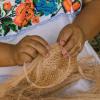
Pieces are handcrafted, using ancient techniques
“Our pieces are made with a lot of work and love, and represent our culture,” says Doña Lucía Ivet Varguez Canul from the town of San Antonio Chum, who is part of Taller Maya. Set up by an organization that supports rural communities in Yucatán and Campeche, the brand is run as a collective, and customers love the fact that it is not-for-profit.
Products are created locally (by makers including Maria Soledad Pam Flores, Ivonne Gutiérrez May and Lucía Ivet Varguez Canuland, pictured here), sold across Mexico as well as online, and employ traditional Maya crafts such as wood carving, weaving, embroidery and filigree metalwork. Handcrafted pieces are also on display at the Folk Art Museum in Izamal downtown, which is next door to the Taller Maya shop. “Being part of Taller Maya provides artisans with a sustainable income for their families, and a way to exchange knowledge, and think collectively,” she adds.
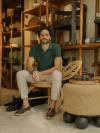
Orozco in his showroom and studio in Tulum
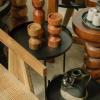
Organic shapes are inspired by the Mexican Caribbean
“I want my designs to convey the excitement, creativity, openness and peace that the coast inspires,” says Daniel Orozco, designer and founder of Daniel Orozco Estudio, whose showroom and studio can be found in the affluent Aldea Zama neighborhood of Tulum. His lamps, totems, chairs, side tables and vases, made in collaboration with local artisans, are carved in unusual organic forms from wood, concrete, stone, seaweed, ceramic and natural fabrics.
“I like challenging design principles. Take a table—why have we settled on a four-leg design? I want to have fun, experiment and discover new shapes and materials, to disrupt people’s spaces and create rooms full of new possibilities,” he says. “All my pieces are inspired by the Mexican Caribbean. If you have a Daniel Orozco in your house, you are in contact with nature.”
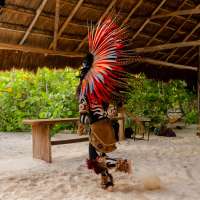
A cultural guide to Tulum
Your essential guide to the best things to see and do in Mexico's boho beach haven
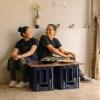
Batún and Sánchez at their Mérida restaurant

Batún loves to use wild ingredients in their dishes
“My first interest in cooking was from the perspective of craft—the simple desire to create something with my hands, like a carpenter,” says chef Abril Batún who, alongside her partner Natalia Sánchez, runs the restaurant Luciérnagas y Cosmonautas (“Fireflies and Cosmonauts”) in Mérida, Yucatán. “Later, I began to use cooking as a way of honoring my grandmother and creating a bond with the women in my family, like a sacred language that connects us.”
Their restaurant is situated in the historic La Mejorada neighborhood, between two art schools. “Mérida is a city with a great creative community. Young artists often come to Luciérnagas and tell us of their new creations,” she says. “The first dish I created here was the inflated corn, stuffed with plátano macho sauce, accompanied with quelites [wild greens]. It is a simple dish—corn, salsa and wild greens—and a concise expression of my vision for a wild kitchen, drawing on the edible herbs and flowers of our country.”

Eduardo “Roth” Neira at work
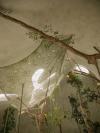
Nature comes first in his structures
“My true intention is to demonstrate that we can build and live with nature instead of destroying it,” says Eduardo “Roth” Neira, the self-taught, self-described “non-architect” and designer of AZULIK Uh May, an art and culture complex in the village of Francisco Uh May near Tulum.
The curving, biomorphic structures were conceived as an intuitive response to the surrounding jungle: No plans were drawn up, and walls were constructed to allow tree trunks to pass through them, allowing all 200 trees already on the plot to be preserved. Roth lives and works at the complex, which also encompasses the art gallery SFER IK Museion, several workshops, and a restaurant. “AZULIK Uh May expresses my way of doing things,” he says. “There’s so much we can learn from nature, just from looking, with respect and an open heart.”
The perfumer: José Miguel Sandovalis

José Miguel Sandovalis at his perfumery

His products draw on local, natural ingredients
“Scents distill the rugged and wild essence of Yucatán,” says José Miguel Sandovalis, founder of Sandovalis, an independent perfumery inspired by the history and botanics of the peninsula. Sandovalis grew up surrounded by nature: “Las Coloradas salt lake with its pink waters, Cancunito beach, the Panabá cattle ranches, and abandoned Franciscan convents in the mountains.” He now lives and works in the peaceful Mercedes Barrera neighborhood of Mérida, where birdsong greets him in the morning.
He studied the world of essential oils and aromatic plants before launching Sandovalis, a range that now encompasses fragrances, soaps, scented candles, shaving products and more, with a focus on artisanal techniques. “We want to raise awareness of traditional arts and crafts in Mexico, and the customs of rural communities.”
